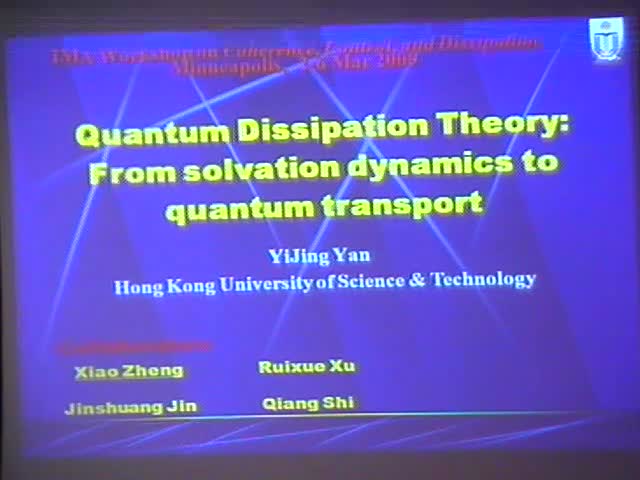Quantum dissipation theory: From solvation dynamics to quantum transport
Presenter
March 5, 2009
Keywords:
- Transport processes
MSC:
- 82C70
Abstract
We have recently developed a hierarchical equations-of-motion
(HEOM) approach to nonperturbative and non-Markovian quantum
dissipation. It is a unified and exact theory for arbitrary
coupling Gaussian environments of distinct nature: bosonic
versus fermionic, and canonical versus grand canonical
ensembles. It admits also an arbitrary time-dependent external
field driving. Two systems will be used to elaborate both the
formulation and implementation aspects of the theory.
In an electron transfer (ET) system, the bath environment
serves as a canonical bosonic ensemble, responsible for the
system decoherence and energy relaxation. The validation of
Zusman equation will be discussed, on the basis of exact HEOM
results.
In a quantum transport setup, a molecule or quantum dot is
placed in contact with electrodes under applied voltage. Each
electrode reservoir serves as a grand canonical fermion
ensemble. It is responsible not only for decoherence and energy
relaxation, but also for the fermion particle (i.e., electron)
transport in/out of the system. The HEOM-based quantum
transport theory will be summarized, together with the
calculated transient currents through model quantum dot systems
and the current spectrums in response to various forms of
external time-dependent applied voltage.
Support from RGC of Hong Kong Government is acknowledged.
R.X. Xu and Y. J. Yan, Phys. Rev. E, 75, 031107 (2007).
J. S. Jin, X. Zheng, and Y. J. Yan, J. Chem. Phys. 128, 234703
(2008).
X. Zheng, J. S. Jin, and Y. J. Yan, J. Chem. Phys. 129, 184112
(2008).
X. Zheng, J. S. Jin, and Y. J. Yan, New J. Phys. 10, 093016
(2008).
